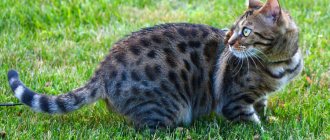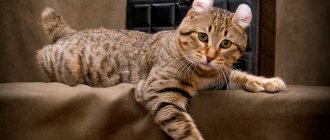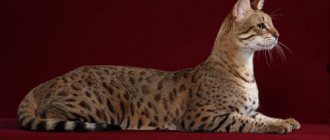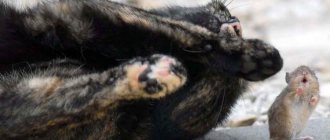The Serengeti is a new breed of short-haired cat that appeared as a result of crossing Bengals and Orientals. Today it is in its infancy. The Serengeti was bred in the USA; in appearance, they resemble the African Savannah cat, but lack the aggression and unwanted instincts of their wild relatives, which makes them comfortable for living next to humans.
- 6.1 Price
Brief history of the breed
This breed of cats appeared thanks to the efforts of the American breeder Karen Sauzman, who decided to breed pets with the appearance of African servals. Before starting work, the woman studied in detail the history of the creation of other similar varieties and took into account past, not entirely successful experiences.
Thus, savanna males are not capable of reproducing offspring until the third generation, and all subsequent generations become less and less like a bush cat. In order not to repeat the mistakes, Sauzman decided to do without the infusion of wild blood.
To achieve her goal, the breeder crossed Bengals and spotted Orientals. The first passed on to their descendants large sizes and bright colors. From the second, the Serengeti inherited large ears, long limbs and a spotted coat.
Later, Maine Coons and Abyssinian cats were involved in breeding work. And already in 1994, Sauzman presented the fruits of her labors to the general public. Today, the Serengeti is considered an experimental breed and has official status only in TICA.
Serval cat
Breeding Features
The Serengeti is characterized by good health and amazing fertility. Most often, a cat has from 3 to 8 kittens in a litter. Most likely, the animal owes its fertility to its ancestor - the eastern shorthair cat. Only specialists should breed such pets. The intervention of non-professionals will lead to dire consequences.
To date, breeders have not yet been able to ensure that only representatives of this breed mate with each other. To improve the phenotype, Oriental and Bengal cats are actively involved.
It should be noted that not every Oriental cat is suitable for mating. Orientals belonging to the old type are preferred. Such animals do not have low-set ears, their shape is rounded, which is very good for breeding. In order to get a cat of a completely different type, breeders only need to slightly adjust the position and shape of the ears , the size of the eyes and the width of the muzzle.
Today's typical Bengals are too heavy-boned and powerful for crossbreeding. For breeding, a tall-legged individual with pronounced ears and a finely speckled color is required. If breeders working to improve Bengal cats are trying their best to reduce the size of the ears, then in this case they are faced with a completely opposite task.
The Serengeti is a miniature version of a wild cat. She will become a wonderful friend, companion and just a joy for the eyes of her owners. It is necessary to provide the animal with high-quality care and a balanced diet, and also remember that breeding rare breeds is a very responsible matter that requires the participation of professionals.
Interesting Facts
Although the Serengeti appeared quite recently, a lot of interesting things are already associated with them:
- The breed was named after a national park in Tanzania, which is home to many African animals.
- Despite its striking resemblance to servals, the Serengeti is not related to these predators.
- Representatives of the breed cannot take part in exhibitions. According to the rules of felinological organizations, this right is granted only to those varieties of cats that are bred by at least 50 registered nurseries.
Breed description, standards, appearance
The Serengeti is a tall-legged, muscular cat with large ears and a long, graceful neck. Her elongated body is covered with spotted fur, which further emphasizes her resemblance to the African serval.
Dimensions and weight
The Serengeti is a large cat with moderate sexual dimorphism. The average weight of a female varies between 8-10 kg. The weight of a male can reach 15 kg.
Anatomical characteristics
According to the standard, spotted cats of the Serengeti breed must have the following characteristics:
- The head, on which large eyes and ears stand out, has the shape of a modified wedge. The chin is strong, the cheekbones and cheeks are poorly defined. The bridge of the nose is wide, without a pronounced stop.
- The ears are large, erect, wide at the base, with rounded tips and a light fingerprint-like spot on the outside of the shell. The length of the ear flap is equal to the height of the Serengeti muzzle.
- The eyes are large and set far away. The Serengeti iris can be amber-gold, hazel, or light green.
- The body is elongated, with strong bones, a flat back, a developed chest and a strong, moderately long neck.
- The limbs are slender, long, with medium-sized oval paws.
- The tail is of moderate length, with a wide base and a narrow blackened tip.
Color and coat type
The body of the Serengeti is covered with short, very thick, shiny fur that feels like silk. Cats of this breed completely lack undercoat.
The breed standard allows the following colors:
- black tabby;
- black smoky with spots;
- silver tabby;
- brown tabby.
On a note. The Serengeti has lighter hair on its chin and belly. Contrasting spots are randomly scattered throughout the cat’s body, and the animal’s tail is decorated with stripes.
Possible breed defects
Exterior disadvantages are:
- stripes on the sides;
- small ears;
- massive or lightweight body;
- spots in the form of rosettes;
- short squat legs.
Choosing a kitten
Due to the lack of a fixed standard for the Serengeti breed, problems often arise with choosing a kitten. Many people rely only on photos. To avoid mistakes, it is recommended to seek help from a professional.
Handsome cat
Typically, they are guided by the following signs in an animal:
- good health;
- clean eyes and nose;
- without pathologies of the limbs, spinal column and tail;
- fatness, activity, sociability.
The baby you are purchasing must have routine vaccinations. Kittens bought from foreign nurseries have chips (this is written down in the passport).
Character and temperament
Serengeti are good-natured and very sociable animals. Spotted cats quickly get used to their owners and persistently demand communication. Representatives of the breed have difficulty withstanding loneliness and can become irritable and aggressive. To get the attention of their owners, Serengetis follow them on their heels, butt heads and even lie down on the computer keyboard.
On a note. Cats of this breed are very talkative. In addition to the usual meow, the Serengeti can growl and make cooing and yapping sounds.
Cats of this breed strive to be leaders in relationships with other pets. With its strong character, the Serengeti is difficult to get along with other pets. They will tolerate the presence of another cat or dog only if they recognize their authority.
The fighting spirit of the Serengeti does not extend to children. Cats of this breed get along well with the owner's children and enjoy playing with them. True, children should know how to properly handle a spotted pet and remember not to offend it.
Acceptable colors
The standard provides for “wild” spotted colors of cats. The most common color of the Serengeti is tabby. This is any shade of brown with a strong contrast between the spots and the main background. Such cats have a white chin, muzzle and lower abdomen. On the ears of animals of this color there is a clear “wild” spot that resembles a fingerprint.
No less common among the Serengeti are the so-called Silver/Smoke cat colors. In the first case, there are contrasting markings on the pure silver body of the animal. In the second, there is a ghostly pattern on a smoky background.
Solid colors are a little less common. Contrasting spots appear on the black body of such animals.
How to choose the right kitten
The Serengeti is a very young cat breed, which is bred in only a couple of dozen catteries. Considering that most breeders live in America, transportation costs are added to the cost of a spotted kitten.
Of course, it is better to choose your future pet in person. If this is not possible, then it is advisable to ask the seller for more photos and video materials. To make your final decision, you need to pay attention to the following criteria:
- availability of documents;
- health status;
- compliance with breed standards;
- behavioral characteristics;
- conditions of detention.
Interesting! The most expensive are Serengeti kittens of the fourth generation from outcross. They are considered purebred representatives of the breed.
Kitten care
The ideal age for a small Serengeti to move to a new home is considered to be 3.5-4 months. By this time, the kitten will have received all the necessary vaccinations and mastered basic self-care skills. In order for the spotted baby to more easily endure separation from his mother and quickly adapt to new conditions, you can ask the breeder for something with the smell of his native “nest”.
The Serengeti kitten is endowed with a restless and curious disposition, so almost immediately after moving it will begin to explore the owner’s house. To prevent the baby from accidentally injuring himself or causing damage to property while exploring the environment, all fragile objects, household chemicals, medicines, ornamental plants and electrical wires are hidden from him in advance. Also, for safety reasons, windows and unglazed balconies are not left open.
Tendency to diseases
Like other mustachioed pets of the Serengeti, they can get sick from time to time. This is influenced by a number of factors: nutrition, care, living conditions, timeliness of vaccination. But in general, the breed has good immunity.
The Serengeti are predisposed to hereditary disorders of the genitourinary system. The symptoms are:
- difficulty urinating;
- bloody discharge in the urine;
- relieve yourself past the tray.
In this situation, you need to contact a veterinarian; self-medication is unacceptable.
Signs of a cat's disease
Care and maintenance
Serengeti are large and very temperamental cats, they are constantly on the move. Therefore, a private house with a spacious area is more suitable for keeping spotted pets.
On a note. The Serengeti have excellent spatial orientation and are not predisposed to a wandering lifestyle. After a walk outside the yard, spotted travelers always return home and often bring with them relatives whom they manage to meet during the walk.
In order for a Serengeti cat to look neat, it is provided with regular hygiene care:
- The animal's eyes and ears are periodically inspected for the presence of discharge and wiped with a cotton pad coated with a special alcohol-free product.
- To prevent tartar, plaque and other dental problems, spotted cats have their teeth brushed several times a week. The procedure is carried out using a non-foaming paste and a soft brush or a special silicone nozzle.
- Twice a month the Serengeti shorten their claws. To avoid damaging the blood vessels, only the transparent ends are cut off.
- In normal times, a spotted cat's coat should be combed no more than once a week. During the molting period, it is advisable to carry out the procedure more often to speed up the process of coat change. It is recommended to bathe the Serengeti 3-4 times a year.
Health of the Serengeti
Serengeti cats are healthy cats that have not inherited a predisposition to dangerous pathologies from their ancestors. They are not susceptible to obesity, heart disease or birth defects. The only serious problem of the breed is urolithiasis. It is characterized by the formation of stones in the bladder and kidneys. They move along the ureters, causing the animal severe pain and discomfort when urinating. Causes of the disease:
- there is too little or too much protein in the cat’s diet;
- hot climate (leads to concentration of urine and, as a result, the formation of stones);
- lack of vitamins;
- failure at the hormonal level;
- viruses, microorganisms.
The most serious disease that affects the Serengeti is ICD
. Symptoms:
- blood in urine;
- frequent trips to the toilet;
- screaming while urinating;
- urination lasts much longer than usual;
- the cat urinates outside the litter box;
- incontinence;
- weight loss;
- depressed behavior;
- convulsions;
- vomit;
- loss of consciousness;
- complete absence of trips to the toilet in small ways.
Treatment depends on the type (acidic or alkaline), which is determined by a special urine test. But both types involve removal of stones by surgery or catheter, anti-infective and special therapy, and diet.
Carefully monitor your pet's condition so as not to miss symptoms of urolithiasis
Feeding the cat
The Serengeti eats both industrial and natural food with equal appetite. Many breeders prefer to give cats of this breed premium or super-premium drying, which is enriched with amino acids, vitamins and microelements.
Best suited for feeding the Serengeti:
- Hills;
- Royal Canin;
- Farmina;
- Acana;
- Grandorf.
With a natural type of nutrition, the basis of a spotted cat’s diet should be meat, offal and ocean fish. It is also advisable to diversify the Serengeti menu with porridge, quail eggs, sour milk and boiled vegetables.
In order not to provoke the development of gastrointestinal diseases, pork, river fish, fresh milk, baked goods, smoked meats, sweets, sausages and any food from the owner’s plate are permanently excluded from the diet of representatives of the breed.
Education and physical activity
Mischievous and jumping spotted cats love walks and active games. The Serengeti can use any small objects as toys. To prevent pets from accidentally breaking their owner’s favorite vase, they should be provided with:
- balls;
- scratching post;
- stairs;
- interactive toys.
Cats of this breed are highly intelligent and resourceful. But at the same time, they are quite stubborn and rarely give up their plans.
Defects in appearance
Work on this breed is still ongoing, and therefore the standards have not yet been officially recognized by international associations of animal lovers. But the defects of the breed include the following:
- two-color spots of unclear outlines;
- spotted inclusions transforming into stripes on the sides;
- squatness;
- light weight;
- limbs not long enough.
It is acceptable to have a light inclusion in the chest and groin area. But snow-white “pants”, the absence of a black tip on the tail and whitish spots on the body are grounds for disqualification. Blue eyes are also not welcome.
Vaccinations and antiparasitic treatment
To protect the Serengeti from viruses and infections, they are subjected to preventive vaccination. The first vaccination against panleukopenia, rhinotracheitis and calcivirosis is given to kittens of this breed at 7-8 weeks.
After 28 days, the babies are revaccinated with the same drug, but with an anti-rabies component. Subsequently, spotted cats are vaccinated once a year.
To prevent diseases transmitted by different types of parasites, the Serengeti is treated for fleas and helminths. Antihelminthics are given to spotted cats every six months, repeated every 10-14 days. Anti-parasitic drops, collars and shampoos are usually used to kill fleas.
Pros and cons of the breed
Before you decide to buy a Serengeti, you should analyze the main advantages and disadvantages of this rare and expensive breed.
| pros | Minuses |
| Beautiful exterior | Small number of nurseries |
| Cleanliness | High cost of kittens |
| Easy to care for | Large dimensions |
Serengeti are graceful domestic cats with an original spotted coat and the appearance of an African serval. Thanks to their striking resemblance to a predator and their sociable, friendly disposition, they make excellent companions for active people.
Price
Since the Serengeti breed is rare and is not bred in Russia, the price for kittens is high. You can buy a baby at a nursery for 1000-2000 dollars.
On a note! Trying to save money, many people purchase Serengeti from random advertisements. As a result, they get not a purebred representative, but a crossbreed. That is why it is so important to have the appropriate documents.
Everyone is blue-eyed










